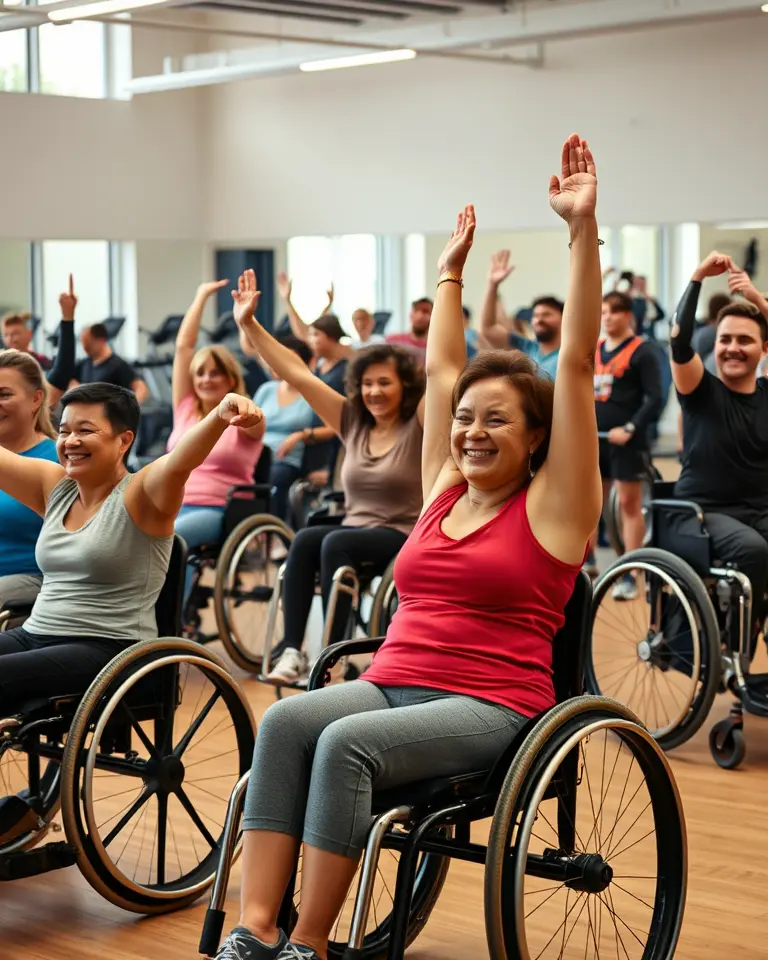The global fitness platforms market for individuals with disabilities is experiencing a period of unprecedented growth, fueled by technological advancements and a rising awareness of the importance of inclusive health and wellness. A recent report indicates that the market, valued at USD 3.38 billion in 2024, is projected to skyrocket to USD 30.78 billion by 2035, demonstrating a remarkable Compound Annual Growth Rate (CAGR) of 22.24%. This surge underscores a significant shift in the fitness industry towards greater inclusivity and accessibility for people of all abilities.
Inclusive Fitness Gains Momentum
The increasing adoption of fitness platforms designed specifically for individuals with disabilities reflects a growing recognition of their unique needs and the benefits of physical activity. This momentum is driven by several key factors:
- Technological Innovations: Advances in wearable technology, mobile apps, and other smart devices have made it easier for people with disabilities to engage with personalized fitness programs.
- Regulatory Support: Government initiatives and policies that promote inclusive fitness are playing a crucial role in market expansion.
- Health Awareness: A heightened focus on both mental and physical well-being among the disabled population is further propelling market growth.
Technological Advancements Driving Adoption
The rise of smart technology is revolutionizing the way people with disabilities approach fitness. Personalized and adaptable solutions are now available through a variety of platforms, allowing individuals to lead more active and healthier lives. These technological advancements include:
- Fitness Apps: Many apps now offer tailored workouts that can be modified based on a user’s specific needs and abilities. Some are even designed specifically for wheelchair users or those with spinal cord injuries, offering exercise recommendations, video demonstrations, and activity tracking. Examples include Accessercise which caters to various levels of impairment and SCI-Ex which focuses on wheelchair users.
- Wearable Devices: Smartwatches and fitness trackers offer metrics tailored to different movement types. For instance, some devices offer specific metrics for wheelchair users, tracking push-based movements.
- Virtual Reality (VR) and Augmented Reality (AR): These technologies provide immersive and engaging workout experiences that can be adapted to diverse ability levels. They offer gamified exercises, which make fitness fun and motivating.
- Biofeedback Devices: These tools help users monitor their progress, allowing for real-time adjustments to their workout routines, particularly beneficial for those with sensory impairments.
- Smart Prosthetics: Advanced prosthetic limbs can be integrated with fitness routines, allowing for a wider range of exercises.
The Rise of Adaptive Equipment
Adaptive equipment is also playing a key role in making fitness more accessible. This includes:
- Wheelchair-Accessible Machines: These machines allow users to perform strength and cardiovascular exercises without needing to transfer out of their wheelchair.
- Recumbent Exercise Bikes: Ideal for those with limited mobility or balance, these bikes provide a full-body workout while ensuring comfort and stability.
- Upper Body Ergometers: Also known as arm bikes, these machines focus on upper body strength, suitable for those with lower body limitations.
- Resistance Bands: These are adaptable and versatile tools used for strength training, flexibility and balance exercises.
- Exercise Balls: Useful for core strengthening, balance, and stability exercises, and can be easily adapted for seated workouts.
Segmental Insights into the Market
The fitness platforms for the disabled market can be segmented in various ways, each highlighting specific areas of growth:
Exercise and Weight Loss Platforms
These platforms currently hold the leading position in revenue generation, with their specialized programs proving effective in improving physical health and mobility.
Activity Tracking Segments
The proliferation of activity tracking segments is driven by the demand for personalized fitness monitoring, helping users stay on top of their fitness goals.
Platform Preferences
iOS platforms currently dominate the market due to the widespread use of Apple devices in developed economies and their advanced accessibility features. However, Android platforms are gaining ground due to their affordability and customizable options, making them accessible to a diverse population.
Device Usage
Smartphones are anticipated to be a major driver in this market, reaching USD 4.3 billion by 2032. Their widespread use and accessibility make them a versatile fitness tool for many.
Regional Market Overview
The North American market is currently leading due to its advanced healthcare infrastructure, high awareness, and substantial investment in technology. However, other regions are also seeing considerable growth as awareness and access to these platforms increase globally.
Benefits of Inclusive Fitness
The importance of exercise for people with disabilities cannot be overstated. Regular physical activity offers a multitude of benefits:
- Improved Physical Health: Exercise helps with weight management, builds muscle strength, improves mobility, and reduces the risk of chronic diseases such as heart disease and type 2 diabetes.
- Enhanced Mental Well-being: Physical activity reduces stress, anxiety, and depression. It also boosts self-esteem, promotes clearer thinking, and enhances sleep quality.
- Increased Independence: Adaptive training can improve self-reliance, helping individuals perform daily tasks with greater ease.
- Social Interaction: Group exercise and sports provide opportunities to socialize, build friendships, and become more involved in the community.
Overcoming Barriers to Fitness
While progress has been made, there are still many challenges that individuals with disabilities face when trying to engage in physical activity. These barriers can be:
- Physical: Lack of accessible equipment, facilities, and transportation to and from fitness centers.
- Psychological: Low self-esteem, lack of confidence, negative body image, and the perception of others.
- Logistical: Geographical limitations, the expense of participation, lack of support, and unsuitable facilities.
- Experiential: Many individuals with disabilities have not had physical activity as a priority, leading to anxiety and uncertainty about how and where to start.
- Social: Exclusion from sports and exercise opportunities by peers who may not believe in their capabilities.
The Future of Inclusive Fitness
The future of adaptive fitness looks very promising, with a focus on innovation and accessibility. This includes:
- Continued technological advancements leading to more customized and user-friendly fitness programs.
- Greater emphasis on inclusive fitness training with more certified trainers who specialize in adaptive techniques.
- Increased availability of virtual fitness programs allowing individuals to access fitness programs from their homes.
- Development of community-focused spaces that foster inclusivity and offer support for individuals with disabilities.
- Growing awareness and advocacy driving the creation of more accessible and welcoming fitness environments.
The global fitness platforms for the disabled market is not just about financial growth. It represents a movement towards a more inclusive and equitable fitness industry where everyone, regardless of their abilities, has the opportunity to improve their health and well-being.







